

GARDENING!
Fifty articles on growing fruits, vegetables and flowers
(Click here to browse 70 topics on my main site ranging from exotic kaleidoscope designs to the strange world of lucid dreaming.)
I keep records of any fruit and vegetable comparison tests I conduct. This page lists the results of those tests. I hope they will be useful to anyone trying to decide which variety to grow for themselves.
Climate always plays a significant role in the success of any given crop. My garden is located in the high desert. Summer highs average 95 degrees with lows around 68. The sun is very intense and most days are cloud-free. The humidity is typically 15 percent or less. If your conditions are much different than this your results may also be different.
Interspersed with the test results are a few tips and gardening tricks that may be useful.
I have been fortunate to have several articles and letters I've written documenting many of these results published in the magazine Organic Gardening.
Here's a list of the tests and other items covered in this page:
NEW!!!
Giant Sunflowers
Sweet
peas
3
bedding plants tested
Gardener
and Bloom brand potting soil
Dot
drip emitters
Leaky
Hoses
Finally...
a leaky hose that works!
Five
gear-drive sprinklers compared!
Baled
vs loose peat moss
Burpee's
Sweet Baby Girl cherry tomato tested
An
Attempt to grow pineapples
SH2
versus SE comparison
Best
SE (sugar enhanced) corn
Final
SH2 (supersweet) corn test results
"Becky"
Shasta Daisy tested
Mounded
morning glories
Pinata
versus Festival watermelon comparison test
A
melon-watering technique that prevents cracking
Grow
an instant jungle
A
grape-thinning experiment
How
to quickly and easily wash dust and wax off grapes
Monarda
and Milkweed tests!
A
food processor in the garden?
Strawberry
hormone spray tested!
Five
flowering bulbs tested!
Long-flowering
iceplant tested!
California
Poppy flowering duration test!
Earthway
Seeder test
Watermelon
comparison
California
Poppy germination test
A
Hint for Growing and Cooking Golden Beets
Watering
Peaches
Reducing
local June Bug (beatle) populations
Foil
bird scarers
Snapdragons
Shredded
leaves versus peat moss for improving soil.
The
great Ambrosia versus Sugar Queen melon test!
Soil
Building Tip
Amazingly-sweet
corn (A new variety)
Verbena
Sandy Mixed
Strawberries
Exotic
Greens
Alyssum
Shasta
Daisies
Leaky
hoses
Garden
Peas
Sweet
Corn
Green
Manures
What
to Grow
California
Poppies
Dry
Bean Inoculant Test
Ladybug
Cages
Junebug
Bashing
Power
of Triple-Digging
Peaches
Drybeans
Forever
Flowers - A Failure
Making
Raisins
Green
Beans
Watermelons
Muskmelons
Cantaloupes
Grains
Spinach
Garden
Productivity Rates
Broccoli
Zinnias
Sweet
Peas
Loose-leaf
lettuce
Honeydew
melons
Romaine
lettuce
Home-grown,
super-rich soil
Cherry
Tomatoes
Sweeter
Grapes
NEW!!! GIANT SUNFLOWERS

As a demonstration to show my grandchildren the principle of experimentation, I had them plant seeds to the three tallest varieties of sunflowers I could find: Kong, American Giant and Mammoth. American Giant was the tallest, measuring a full 12 feet after only three months of growth. Kong was a close second. All the plants were inpressive, especially considering that they grew close together in beds only 30-inches wide. For such tall plants the flowers were surprisingly small, barely 8-inches across. The children were amazed by the rapid growth and eventual size.
SWEET
PEAS
My first experience with sweet peas wasn't good. The plants trailed everywhere creating a tangled mess, the flowers were small and the stems far too short for cutting. I thought I was done with them until my wife gave me a sweet pea book for Christmas and it interested me enough to try them again.
This time I paid top dollar for the very best seed, selected 18 of the most fragrant and attractive varieties, started them in late Fall and grew them using the cordon method (a single vine) to encourage the largest flowers and longest stems.
While the results were much better than the first attempt they were still disappointing. While the fragrance of several, like Anniversary and Fire and Ice, was very strong, even a dozen stems couldn't hold a candle to the power of a single Fragrant Cloud rose. Worse still, the fragrance ran out after two days whereas roses keep going for a week or more. Additionally, the flowers of many varieties don't look nearly as attractive as their advertised pictures. Years of testing flower varieties has gotten my used to this but in these sweet peas it was worse than typical.
Growing sweet peas using a cordon system is very time consuming in that the vines have to be checked almost daily to nip off side shoots.
Don't get me wrong. Sweet peas are wonderful plants to grow, but for me they take too much time and effort for the amount of return. For fragrant cut flowers I'm sticking with Fragrant Cloud hybrid tea roses.
Varieties tested:
Prince
of Orange
Anniversary
Charlie's
Angel
Solar
Flare
Albutt
Blue
Flamenco
April
in Paris
Fire
and Ice
Gwendoline
Hi-Scent
Honeymoon
Oban
Bay
Concorde
Percy
Thrower
Royal
Rose Pink
Pamela
Sea
Wolfe
Richard
and Judy
3 bedding plants tested
I tried Cosmos Cosmic red, yellow and orange:

And wasn't impressed. They did a very poor job of self cleaning old dried flowers heads so that after the first bloom the plants looked brown and tired the rest of the season, much worse than the photo shows.
I also gave Park's Pink Sonata Cosmos a try and was equally disappointed in it. First, the Park catalog clearly showed this variety as having a darker pink eye around the center.
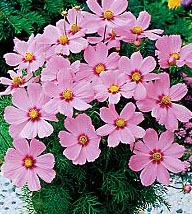
None of my plants had the dark pink eye. Below is what mine looked like:
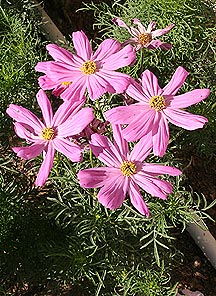
Second, the bloom time is extremely erratic. Some were in flower two months after planting whereas others are over five months old and haven't even started showing buds much less flowers.
Finally, like the Cosmic Cosmos, the Cosmos Sonata Pink plants that did flower do a very poor job of self-cleaning. Weeks go by while annoyingly persistent old buds make the plants look old and tired.
On the positive side I found a great Vinca named "Apricot" at Home Depot in Spring of 2008.
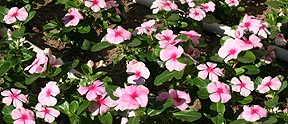
This compact plant self cleans old flowers so quickly you never notice them, it stays covered with extremely attractive flowers all Spring, Summer and Fall, and it remains short and neat all the time. I've never been a fan of Vincas but this one has me sold. The flowers seem larger than all others and the blushing pink with brilliant center is a real eye catcher.
UPDATE!!!
I liked this vinca so much I looked for them again in 2009 only to discover that they weren't available anywhere. Frustrated, I tried finding them in seed calalogs but the vincas named "Apricot" didn't look like the one I'd purchased. Further research turned up three vincas that sounded like they might be the ones I wanted. I ordered seeds to all three and grew them. Here's what I got:

Solar Apricot..................Pacifica Blush..................First Kiss Blush
Pacifica Blush was the closest to what I remembered. It's intense, almost shocking, pink glow is much richer than shown in this photo.
PRODUCT
WARNING!!!
Gardener
and Bloom brand potting soil
In Spring of 2007 I purchased four bags of Gardener and Bloome's Rose Potting soil and used it to plant 77 pots with zinnia, tomato, melon, Canterbury bell and salvia seeds. The results were a complete disaster. Although I followed my regular routine for growing seedlings, a routine that's worked flawlessly for over 20 years, the plants that came up grew poorly, exhibited many disease symptoms and 30-percent died. Upon testing the soil I discovered that in spite of the package advertisements stating that the soil contained a wide spectrum of organic amendments such as bat guano, worm castings, kelp meal, alfalfa meal and so forth, the soil was completely lacking in nitrogen, potassium and phosphorous. Even after adding extra fertilizer the plants grew poorly. I've used many potting mixes over the years and this is clearly the worst. Perhaps I got a bad few bags out of what may otherwise have been a a good production run, but for myself I will never use this product again.
Dot drip emitters
I purchased a dozen Dot brand 1/2-gallon per hour automatically pressure regulated drip emitters and tested them on a 5/8-inch diameter hose. The package stated that they provided the same amount of flow regardless of pressure (limited to 60 psi.)
I found that the emitters varied their output by a factor of three as the pressure changed from 10 psi to 40 psi. Additionally, the output rate varied from emitter to emitter: some barely dripped, others had water streaming from them.
I'd rate these as poor self-regulating emitters
Leaky Hoses
As attractive as these hoses appear, I have found that they universally, with one exception, do not distribute water uniformly along there length. The worse offenders are the high-pressure hoses with two or three channels that feed a series of holes or slits down their length. The first five feet of a fifty-foot long hose will spray out four times as much water as the last five feet. The popular black, porous hose made out of old tires isn't much better. 5/8-inch diameter hoses leak 2-3 times as much water out of the beginning as the end. There is one hose that does a very good job. It's a porous hose called The Ultra Earth Quencher and is made by Swan, that's like the tire hose but it's more gray in color and the pores are much finer, so fine that they claim it can be buried and plant roots won't clog it. When I tested it, the first five feet of a fifty foot length delivered only 34 percent more water than the last five feet. Reducing the pressure to a trickle made the delivery rates almost equal at both ends. The only bad thing about this hose is that it costs $14.00 for a fifty-foot length and I've only seen it in Alberton's grocery stores.
Swan hose update!
Several years after writing the above article, I decided to use a large number of Swan hoses to make an underground watering system. Although these hoses had worked excellently by themselves, I found out that using many of them in parallel doesn't work. The problem is that while the porosity is uniform along the length of each hose, from hose to hose it can vary by as much as a factor of twenty. Some of the hoses in my system barely got damp on the outside. Others poured out a flood of water.
Gilmore to the Rescue!
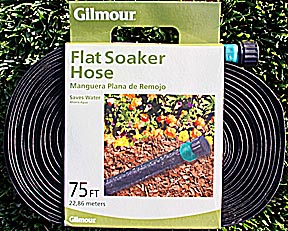
Always on the lookout for new leaky hoses to test, in 2009 I found this offering by Gilmore. It consists of water tight nylon cloth sewn into a tube, which measures 1/2-inch in diameter when inflated. The small diameter and long length made me skeptical but I'm happy to announce that the flow rate per running foot at the very end of the hose is only 10-percent less that the first foot. This is outstanding. Most of the water leaks from the seams where the tube is sewn together rather than through the cloth itself. If this hose were placed on a gentle down slope the flow would be even throughout its entire length. The dark color should block light which in turn should reduce the growth of algae inside the tube, a real flow killer for many leaky hoses. The nylon feels very durable.
Finally... a leaky hose that works!
I'm happy to report that I've found a leaky hose that works: the model ST100R drip soaker by DIG ($7.99 per 100' at H&E stores.) It has 0.85 gph drip emitters every foot along a 16 mil black tube that's 1/2" in diameter. I measured the flow rate from the first emitter in the line and the 100th (100' away) and they both produced exactly the same amount of water.
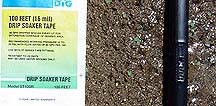
My Leaky Hose System
So, which leaky hose system do I use? None of these.
While working with them I discovered that what I wanted was a system that was cheap, reliable, readily available and shows that the water distribution rate is equal every where. Since I couldn't find such a system I decided to make my own. I call it dribble irrigation.
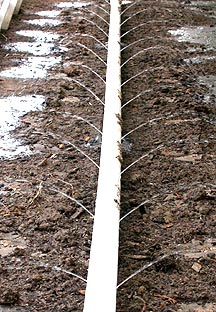
I drill two rows of 0.038-inch diameter holes six-inches apart at a 90-degree angle down the length of a 3/4-inch diameter PVC tube. (Search Amazon.com for micro drill sets. One of these only costs a few dollars. The 0.038-inch bit is the largest in the set.) I can connect four of these tubes in a line and as long as the soil is level they will put out essentially the same amount of water per hole from end to end. Better still, it's easy to spot when one hole's gotten clogged because the arc of water doesn't match its neighbors. By varying water pressure I can control very precisely the rate of irrigation.
I also drill an extra hole every four feet on the bottom of the tube to let all the water drain out when the supply is turned off. Without this the trapped water breeds algae that'll clog the holes.
This dribble system is very flexible because the sections are easily cut and reconnected as needed to match the needs of varying garden plans. Best of all they last for years, decades actually. The only problem is that drilling all those holes does take time and patience. But, for a durable, adaptable watering system that provides extremely uniform watering it's well worth the effort.
NEW!!! Five gear-drive sprinklers compared!
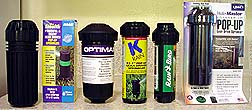
All of the sprinklers tested pop up four inches in use. From left to right:
NAAN Stealth: (Shown next to its box.) $16.99, comes with five nozzles to tailor the discharge, good instructions, riser was difficult to open and the side to side adjustment very awkward.
Water distribution measured from the sprinkler with a #9 nozzle at 45 psi:
10' = 1"
of water
20' = 3/4"
30" = 1/2"
40' = 3/8"
44' = 1/8"
Optima:
$9.99, no additional nozzles provided, almost no instructions and
the little that were provided were vague to the point of being
worthless, very difficult to make adjustments, in operation it gave
off a loud clicking sound that was almost as loud as an impulse
sprinkler, oscillates very fast.
Water distribution measured from the sprinkler at 45 psi:
10' = 3/4"
of water
20' = 3/4"
30" = 1/2"
40' = 0"
44' = 0"
Rainbird:
$11.99, easy to understand instructions, simple to adjustment, gives
off a lot of very fine spray, only comes with one nozzle, dumps a lot
of water in the first eight feet.
Water distribution measured from the sprinkler at 45 psi:
10' = 1"
of water
20' = 3/4"
30" = 1/2"
40' = 0"
44' = 0"
K Rain:
$9.99, good instructions, very easy and simple to adjust, comes with
adjusting tool, no optional nozzles, produces an enormous amount of
fine mist, barely reached 30' at 45 psi.
Water distribution measured from the sprinkler with at 45 psi:
10' = 1"
of water
20' = 1"
30" = 1/8"
40' = 0"
44' = 0"
(BEST
CHOICE!) Orbit
WaterMaster Voyager II: $11.96 (at Wal-Mart), the best
instructions of the five sprinklers tested, the easiest to adjust,
longest range (52' at 45 psi with a #12 nozzle), comes with 12
optional nozzles and a very user-friendly adjustment tool. Many of
the nozzles produce large drops which are less effected by wind than
any of the other sprinklers but if you want fine mist there are
several nozzles that can provide it.
Water distribution measured from the sprinkler with a #8 nozzle at 45 psi:
10' = 1
1/4" of water
20' = 3/4"
30" = 5/8"
40' = 1/2"
44' = 1/8"
Water distribution measured from the sprinkler with a #9 nozzle at 45 psi:
10' = 3/4"
of water
20' = 5/8"
30" = 1/2"
40' = 1/2"
44' = 3/8"
(This was
almost perfect for the 44' x 58' grassed-in area of my backyard. One
sprinkler at each of the four corners provide a very even water
distribution over the entire area.)
Water distribution measured from the sprinkler with a #10 nozzle at 45 psi:
10' = 1"
of water
20' = 5/8"
30" = 3/4"
40' = 3/4"
44' = 5/8"
Baled vs Loose Peat Moss
One cubic foot of baled or compressed peat moss fluffs to 1.4 cubic feet after thoroughly breaking it up. A two cubic foot bag of loose peat I purchased actually only measured 1.8 cubic feet. Dividing the cost by the volume shows that the the baled peat from Lowes ($6.35 for 2.2 cubic feet in 2007) cost $2.88 per cubic foot when uncompressed. The loose bagged peat ($9.98 for 2 cubic feet (1.8 cubic feet actually) from Home Depot in 2007) cost $5.55 per cubic foot. Breaking up baled peat is a hassle but if you need a lot of it the savings can add up. I used to be able to find 3.8-cubic foot bales that were much cheaper per uncompressed cubic foot than any other option, but starting in 2007 I was no longer able to find them in my area.
Like like using peat because its acidic PH of 3.8 helps neutralize the naturally alkaline soil in my high desert location.
Note: Many bagged peats come treated with wetting agents and chemical fertilizers so if you're an organic gardener you may want to check the small print.
Burpee's
Sweet Baby Girl tomato tested!
Burpee's new Sweet Baby Girl cherry tomato is a winner! I compared it to those two famous super sweets Sugar Snack and Sun Cherry. Sweet Baby Girl was clearly sweeter and less acidic than Sugar Snack. But, Sun Gold still holds the top spot.
An Attempt to Grow pineapples
I've grow pineapples before, but something always came up to prevent them from producing fruit. I'm taking another swing at it starting in August of 2003. It takes 18 months or more to produce a pineapple so please check back often for progress reports.
Why grow a pineapple? Because ripe pineapples are so high in sugar that they begin fermenting in as little as 24 hours. That makes purchasing a good pineapple difficult. If it was picked ripe, by the time it gets to market it's starting to go bad. If it's picked green it'll hold better but then you miss out on the full flavor potential of what is considered to be the king of fruits.
The first step is to twist the crown off a pineapple. Cut away any pulpy material from the core because it'll rot and kill the plant. Then pick off all the leaves from the bottom inch of the crown. This exposes small nodules that will grow into roots.
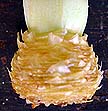
Place the crown in a glass and fill it with water so the base is just covered. I find a narrow wine glass works well.
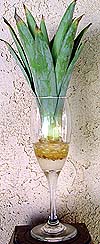
Put the glass in a bright shaded area for 4 to 6 weeks to let the roots grow. Be sure to check the water ever day to make sure the plant doesn't dry out. I've heard that pineapple crowns can absorb water directly through the crown so I prefer to pour the water in there.
First update!
No matter how carefully I trim off the pulp on the bottom of the crown, I find that some mold always grows there. Left unchecked, this mold could overcome the plant. An easy way to get rid of it without injuring the roots is to use a mild jet of water from a kitchen sink sprayer.
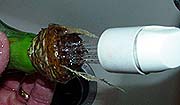
Every time I add water to the glass, I check for mold. If there is any mold I spray it off. A hand-pump sprayer might also work. I'm also careful to thoroughly water out the glass so that mold and diseases don't build up inside.
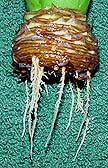
After six weeks the roots are an inch and a half long and the crown needs to be moved to a taller glass so that the roots don't bunch up in the bottom. Every time I water I add a very small pinch of general purpose water soluble plant food to give the pineapple something to chew on.
Second update: Planting day!
Two months after placing the crown in water the roots grew to be two and a half inches long. Time to plant.

I planted it using the same technique used for strawberries, I dug a hole, formed a three-inch tall cone of moist soil in its center, placed the crown on top of it so the roots trailed down the sides and carefully backfilled the hole. A deep watering finished the planting.
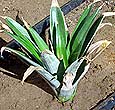
Because it was planted in fall, I placed the pineapple close to a white, south facing wall. The wall will prevent frost and sunlight reflecting off it will encourage the pineapple to grow through the winter.
A folded sheet of poster board created a tent over the pineapple to protect it from the sun until the roots have a chance to take hold. After one week I removed the posterboard in the rear. This gave the pineapple reflected sun. After a second week I'll removed the front sheet and the pineapple will receive full sun.
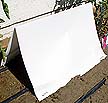
(Please check back soon for the latest update.)
OPPS!!! I took the cover off too soon and then got hit with a heat wave. The result was that the roots had not developed enough to support the plant. It died. Oh, well. I'll try again next year.
SH2 versus SE corn comparison!
I've read in seed catalogs that SH2 (supersweet) corn is three times sweeter than normal or hybrid corn. SE (sugar enhanced) has a genetic makeup that greatly slows the conversion of sugar to starch so that it stays sweeter longer. The implication is that the SH2 varieties should be the sweetest corn available. Based on the tests I present below, I confess that I could not taste a significant difference in sweetness between SH2 and SE corns. Also, their textures, contrary to some claims, were the same. However, SE corns do have two advantages: they don't have to be isolated from non-SE corn (SH2 corn will retain good quality only if pollinated by SH2 corn.), and the number of available varieties is much greater than SH2.
Freezing hint: I experimented with the best way to freeze corn for later consumption and found that the best texture after being thawed comes from corn frozen fresh-picked. Corn that has been cooked or even merely blanched tended to turn gummy when thawed.
NEW!!!
Best
SE (sugar enhanced) corn!
I tested the following SE-type sweet corns and got the following results:
Bodacious - Small to average ear size, very tight wrapped leaves, good corn flavor, not gummy, little insect damage
Breeder's Choice - Average to large ear size, not sweet enough
For Heaven's Sake - Better flavor than Breeder's Choice, but hard to pick. Kernals have a nice "pop" when eaten.
Sugar Buns - Thin ears, virtually every ear had a worm in it, very loose wrappers, weak flavor, gummy texture
Legend - Average ear size, tight wrappers, 10 percent infected with worms, sweeter than Sugar Buns but weak corn taste, gummy texture
Ambrosia
- The winner!!! Delicious,
perfect sweetness/corniness flavor, very little worm damage, big,
beefy, beautiful bicolar ears, great eating whether raw and even when
over cooked, never gummy, kernals have a good "pop."
Early & Often - Average to large ears, no insect damage, not sweet enough, a little gummy
Wardance - A mostly yellow bicolor with average ears and flavor. Ambrosia is much better
Kandy Korn - Average ears, no insect damage in spite of the fact that most of the ears grew out of the wrapper leaves, ears were poorly filled, very tender, average flavor
Precocious - Very small ears, poor flavor, gummy texture
NEW!!! Best SH2 (supersweet) corn test final results!
I tested the following SH2-type sweet corns with these results:
Butterfruit Bicolor - Beautify, big ears with excellent fill and great taste. Virtually identical to the SE variety Ambrosia.
How Sweet It Is - Mostly white kernels, small ears, bland flavor.
Fantasy - The winner! Medium-sized ears filled with large, coarse kernels. Not as sweet as Butterfruit but it has a richer corn flavor. The real winning characteristic with this variety is that the kernels are unusually deep, so when you take a bite you can really sink your teeth into it. All the other corns have shallow kernels and eating them is more like scraping a thin layer of food off the surface of a wooden dowel. For its taste and this big-bite characteristic, I'm making Fantasy my top pick.
Honey and Pearl - I tried two different plantings of this variety (seeds supplied by Parks) and they both failed to germinate. I didn't have any problems with any of the other varieties I tested so I assume the problem was this the seed.
NEW!!! "Becky" Shasta Daisy tested!
Burpee sells a low-growing daisy named "Becky." I found this little plant to be outstanding. The foliage stays neat and only grows 10-inches high. The flowers are held aloft on short 14-inch stems that are too short for cutting. The flowers themselves are of average size and I thought the centers were slightly too large for the petals. After two weeks of sporadic flowers, the plants were covered in blossoms for a full month. I believe these plants would be ideal for massed plantings to provide a carpet of white flowers in early summer.
NEW!!!
Mounded
morning glories!
I planted several plots with a dozen morning glory seeds in a 2-square-foot area to see how they would look if grown without support. The results were disappointing. The plants formed aggressive mounts ten feet in diameter and three feet high but produced no, or very few flowers. The few buds that did form were mostly hidden under the foliage. I can't recommend this planting idea.
NEW!!! Pinata versus Festival watermelon comparison test!
Festival is slightly sweeter and darker red than Pinata. Also, Pinata tended to have internal cracks so Festival is the clear winner. BUT... both melons pale in comparison to the winner of several previous tests: the open-pollinated Dixilee.
NEW!!! A melon-watering technique that prevents cracking!
Every year I lose several melons because the crack. The reason is that after drying out a little, I'd water them and the sudden availability of water caused the plants to pump water into the melons. They'd expand faster than the rinds could grow or stretch. This year I avoided that problem by dividing the area around each plant into four pie-shaped basins. I'd fill one basin a day, working around each plant on a clockwise direction. This provided the plants with a constant, even rate of water, which eliminated the rapid expansions that caused cracking.
NEW!!! Grow an instant jungle!
As a child, I loved it when my parents would take me to the local arboretum to play in the bamboo jungle. With the birth of my grandson, Joshua, I began figuring out how I could give him the same fun. The problem is that we live in the desert where jungles are scarce. After some research, I decided the quickest and easiest way to let him play in a jungle was to grow one. In stead of bamboo, I used several different types of sunflowers. They grow quickly, explosively is more like it, seed is cheap and available, they're easy to plant and easy to grow.
To test this idea, I planted Paul Bunyan (12 feet tall) Mammoth Russian (9 feet tall) and Sunbeam (6 feet tall) in three test plots of 100 square feet each. Within 80 days I had my jungle and it was a good enough approximation to the real thing for children in the 3-9 year-old range to enjoy. However, if you're thinking of doing this there are a few things to consider.
First, the very tall varieties are not good how creating a dense jungle. The lower five feet of their stalks are so bare of leaves there isn't enough density of foliage to create a good jungle sensation. The shorter Sunbeam variety had dense leaves all the way to the base of the plants, perfect for kids to hide in. My advice would be to select a variety that only grows 6 feet high.
Second, Keep the jungle-to-be well weeded. If not, the undergrowth becomes so dense it's hard to walk through.
Third, to give the kids enough roam to roam, the jungle should be at least 20 x 20 feet. When it come to jungles, the bigger the better.
Fourth, plant the seeds 18-inches apart.
Fifth and finally, be aware that after the season's over, you're going to have to take the jungle out. This can be a lot of work.
By the way, contrary to what was printed on the seed packages, Mammoth Russia grew taller than Paul Bunyan. Also, Mammoth Russian had larger seed heads but a higher percentage of them were deformed. Sunbeam is advertised as have a bright green center to its flowers. The centers are green but not as bright as the pictures indicate.
NEW!!!
A
grape-thinning experiment!
Every year 1/3 of my grape clusters are infected with a black mold that's messy to wash off. Reasoning that the mold grew in the center of the clusters where it's more humid, I thinned each cluster by trimming each finger in the cluster to half its natural length. The result was that not one of this year's clusters had any mold. An added benefit was that the trimmed clusters had an attractive cylindrical appearance, ripened more uniformly, and washed easier.
NEW!!!
How
to quickly and easily wash dust and wax off grapes!
Grapes have a wax coating that protects them and, unfortunately, collects dust that's difficult to wash off. This wax-and-dust coating can give grapes a woody, dry, or chalky taste. I discovered that it can be removed instantly by dunking a grape cluster for a few seconds in a pot of boiling water. I them move the grapes to a pot of ice water to prevent any cooking. The resulting grapes are free of dust and wax and taste much sweeter and cleaner.
Monarda and Milkweed tests!
With the idea of building up a section of the garden designed to attract butterflies, I experimented with two highly lauded plants for that purpose: Monarda (Bee Balm) and three different types of Milkweed.
The Monarda is a very neat, clean, upright plant about 4-feet tall. It flowers for one month starting in June in my high-desert area. It doesn't seem to be bothered by any pests. Yet I dislike it. The plant color is a dull gray-green and has an unpleasant odor. The flowers are okay but the center wilts after a few days casting a dull gray hue to it. As nice as the plant form is, I can't recommend Monarda.
I tried tropical, swamp, and butterfly milkweed and was disappointed with all of them. They take a long time to germinate (25 days), germination rate is low, they grow very slowly I'd describe tropical milkweed's growth rate as glacial.) and worst of all I have never seen a plant that attracts aphids faster than these. Weekly soakings in insecticidal soap was not enough to keep the problem under control.
After these experiences I'm giving up on the butterfly patch.
A food processor in the garden?
Every year I have a problem chopping up corn stalks. Invariably, the resulting pieces are too large to till into the soil and even if I do, they decompose to slowly. Them I got an inspiration. Wal-Mart sells a GE variable speed food processor with a side discharge opening. It only costs $40.00, much cheaper than a chipper shredder. I cut the bottom off the output discharge so that it wouldn't jam and ran a 10-foot sunflower stalk through it. In seconds, the woody stalk was reduced to a neat pile of finely shredded green manure. Now... if I could only think of something that would take care of my melon vines?
UPDATE: The food-processor idea ended up not working out very well. Corn stalks turned out to be too tough and fiberous. The processor kept jamming. I've found three companies in Britain that make small electric chipper shredders, but none in the United States. Thank you.
Strawberry hormone spray tested!
Most garden centers and mailorder houses offer a product called "Berry Set" or "Blossom Set" which claims to use a hormone to boast the number and size of berries. It's usually used on strawberries. I got some made by Bonide and tested it in my strawberry bed. I was careful to use alternating plants for the test to make sure that and differences were the result of the spray and not that one section of plants got more water or fertilizer than another. Twenty-two plants were sprayed while another twenty-two weren't.
Over the duration of the test, the first two week of production, the sprayed plants produced 48 berries with an average weight of 20.6 grams. The total weight was 990 grams. The unsprayed plants produced 64 berries with an average weight of 17.2 grams and a total weight of 1100 grams. While the sprayed berries were larger, the total production was less than the unsprayed berries. This test indicates that this spray is a waste of time, money, and effort.
I could detect no flavor difference between the two groups.
NEW!!! Five flowering bulbs tested!
The following are commonly available bulbs at department and variety stores:
Trumpet Golden Harvest Daffodils: 12 for $4.97. A nice, though unremarkable, yellow daffodil. Bloomed for almost two weeks.
Large-Cupped Carlton Daffodils: 24 for $3.66. Larger flowers than above and a purer yellow. Bloomed for two weeks. Slightly later than the Golden Harvest Daffodils.
NOTE: The two daffodils mentioned above are perfect compliments to each other because the Carltons started blooming on the same day the Golden Harvest Daffodils stopped blooming. Together they gave me a full month of uninterrupted bloom.
Mignon Patio Dahlias, Yellow Sneezy: 3 for $4.00. Terrible! Although the produced over twenty blooms per plant and these came over a long season, not one of the blooms opened cleanly. They were all deformed, wilted, and ugly. I suspect that they didn't like the alkaline soil, intense sun, or some pest in my area. I recommend staying away from these bulbs if you live, like me, in the high desert.
White Prosperity Gladiolus: 10 for $2.27. Excellent! Long stems of pure white flowers. Bloomed in June in the high desert for three weeks.
Wigs Sensation Gladiolus: 10 for $2.27. Disappointing. They had the same bloom season as White Prosperity but the number of flowers were less and instead of the pure red shown on the label, the flowers were an insipid orangy-red.
NEW!!! Long-flowering iceplant tested!
Last year I started growing an iceplant from Burpee named Starburst that claimed to to flower from frost to frost, unlike most iceplants that only flower for a couple of weeks. I'm happy to report that the claim is true. Mine started flowering in mid-March and kept on doing so until the first frost at the end of November. That's the good news. The bad news is that the flowers are small, weak magenta in color, and never completely cover the plants. Most of the time the coverage is less than ten percent.
NEW!!! California Poppy flowering duration test!
My over-wintered California Poppies started flowering in early March, hit their best at the end of April, and by the end of May were looked droopy and stringy. The period of best display was for one month. One nice thing people forget about California Poppies is that in addition to being perennial, they are also evergreen. In spite of repeated hard frosts, mine stayed neat and green all winter long. The big problem is that by summer they have grown so long and rangy that they are a mess to clean up. It would be interesting to trim them off short and see if they'd grow back for a fall flowering season.
Planting a large plot, in my case 400 square feet, resulted in some unusual specimens. While most of the 500 plants were the expected bright orange, a dozen had beautiful lemon-yellow flowers and two were white.
Earthway Seeder Test
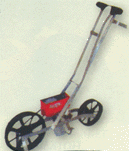
The Earthway seeder is a two-wheeled push seeder that digs a furrow, drops seeds into the furrow, and covers them all in one operation. I've wanted one of these for years but the $80.00 price tag made me wait until now. My only regret about getting one is that I didn't do it sooner. This seeder is outstanding. It pushes through even untilled soil easily and quickly, placing and covering a wide range of seeds with 1/8 to 2-inches of soil. Mine came with seven seed plates that easily switch out to pick up whatever size seed is needed. It works best with large, uniform seeds like corn, peas, and beans. Small seeds like carrots or broccoli tend to get sown too heavily. Here are the sowing densities for several seeds:
California poppies, broccoli, cabbage using the carrot seeding disk - 21 seeds per foot
Carrots using the carrot-seeding disc - 9 seeds per foot
Beets using the beet disk - 27 seeds per foot
Beans using the bean disk - 5 seeds per foot
Corn using the corn disk - 3 seeds per foot
For small seeds that tend to oversow, I recommend using tape to cover up half or more of the holes on the seeding disk to cut down on the sowing density and thereby reduce the amount of thinning that'll be needed once the plants are up.
Watermelon Comparison
I compared Dixielee and Legacy (both open-pollinated) watermelons in 2001. The Dixielee was sweeter, earlier, and darker red, but it only gave me one melon before a disease killed it. Legacy produced nine, 35-pound melons and remained healthy all season, but the melons took two months longer to ripen than Dixielee - although I think that might be because the Legacy plant had a hard time ripening so many melons at once. Even allowing for that, I think I still prefer the dark, intense red flesh of Dixielee... I just need to get a better handle on the diseases. Oh, yes. If left on the vine until completely ripe, Dixielee's heart tends to get pulpy. They color and sugar-up early so I recommend picking them early. Wait until the white spot where the melon rests on the ground to turn yellow but pick them before they give off a hollow thud when rapped.
California Poppy Germination Test
In 2001 I planted California Poppy seeds both on the surface, as directed by the seed packet, and 1/8-inch below the surface of the soil and watered them evenly every day. The buried seeds, contrary to what the seed packet said, had almost 100 percent germination whereas the surface-planted seeds had zero germination. In spite of statements saying that California Poppies require sunlight to germinate, this test indicates that you'll have better luck if you cover them slightly.
Growing and Cooking Golden Beets
If you let golden beets grow until they are three-inches across they are difficult to cook by boiling. By the time the centers are done, most of the outsides have been over-cooked the the point where they are washed out in color and flavor. The solution is to plant these beets closer, 3-4 inches apart, and pick them when they are only 1 and 1/2 inches indiameter. They cook quicker and after the skins come off they are perfectly bite-sized. Better still, they cook evenly with no washed out exterior.
Watering Peach Trees
I read somewhere that it's best to water trees deeply, soaking the soil 4-feet deep, every other month. I tried this with my peaches this year and almost lost my entire crop. Research showed the error of my ways. Peach trees are unusual in trees in that they have shallow roots. Consequently, they need to be watered every week.
Local June Bug Population Control
The accepted view of bugs is that they come from an inexhaustible reservoir and while we can temporality reduce their populations, it is impossible to do anything that has a lasting effect on their numbers. Something I did last year proved that this is not always the case.
Scroll down 19 articles and you'll come to one titled June Bug Bashing. In it, I describe how I made a game out of whacking June bugs with a badminton racket. That sounds odd but the reality is that over a four week period I killed hundreds, almost every one that came into my yard, of June bugs (large flying beatles). This year I have seen many fewer June bugs which indicates that last year's efforts might have had an effect.
Foil Bird Scorers
I tried hanging long aluminized strips of thin plastic in my peach trees to scare birds away. It worked... for two days. Then the birds figured out the flashing strips couldn't hurt them and they feasted on the peaches. I'd say the foil strips are a waste of time.
Snapdragons
Gardening books state that Snapdragons bloom all summer long. They do... but to keep the plants flowering to full potential and looking clean, it's necessary to cut off the spent bloom stalks. There's the problem. The first stalks are singular and tall: easy to cut. After this first cut each plant sends up three to five smaller stalks that are sorter than the first main stalk and harder to clip out. The third set of stalks, after the first are removed, turn the plants into tight bundles of very short stalks that are tedious to remove. What this boils down to is that during my test, while the Snapdragons did flower all summer, the amount of work to keep them looking good wasn't worth it.
Shredded leaves versus peat moss for improving soil
Last fall I amended one bed with peat moss and another with shredded leaves to see which was better at improving soil. Both amended beds had excellent drainage and grew plants well. But, whereas the peat moss bed always seemed dead or sterile, the bed with the shredded leaves was loose, spongy, deep black, and teaming with worms. The peat bed had very few worms. My recommendation would be to choose shredded leaves over peat moss.
The Great Ambrosia versus Sugar Queen Melon Test
Over the last fourteen years, I've tested sixteen different muskmelons, the corky-skinned melons in grocery stores, and came to the conclusion that the two best were Burpee's Ambrosia and Whilite's Sugar Queen. This year I conducted a head-to-head comparison between these two outstanding melons to decide who was the undisputed champion. Both plants grew in a bed optimized for melons, were extremely vigorous and disease free. Although both produced many melons in the 15 percent sugar range, Ambrosia was the clear winner. It's flavor was cleaner (Sugar Queen has a slight grassy taste if not ripened to the point of being almost over ripe.), the melons were easier to find (Sugar Queen plants are so heavy many melons are completely hidden by the foliage.), Ambrosia was more succulent and the flesh was a darker orange. Numerous articles on melons also comment that Ambrosia is extremely adaptive to a wide variety of conditions. Grow it and you're sure to have some good eating!
Important update! My Ambrosia vine was growing great, then last week I went out and in one day it had died. I assume some virus kicked in and wiped the plant out. This event reminded me that this has happened several times in the past, indicating that Ambrosias are sensitive to something in the soil. In the mean time, the Sugar Queen vine is still pumping out very sweet six-pound melons in spite of a heavy aphid infestation and the plant appears healthy and strong. For these reasons, even though at its best Ambrosia is a slightly better tasting melon, I'm changing my vote and saying that Sugar Queen is the winner of this comparison grow-out.
Soil-Building Tip
The two best things to aim for when improving soil are to increase the amount of organic matter and correct the PH (soil acidity) to 6.5. After many years of working to improve my own soil, I've found a three-step process works best to convert my high-desert dirt into rich soil.
In fall, I till forty to sixty 39-gallon bags of shredded leaves and two 20-pound sacks of organic 5-5-5 fertilizer into a 400-square-foot plot (10 inches deep) and let the worms chew on everything until April. By that time the soil has been transformed into a deep, rich, black, spongy soil that is a joy to work with.
The only problem is that worm castings, which now make up much of the soil, are alkaline and soil PH is up around 7.8. To correct this, I add twenty 2.2 cubic foot (compacted) bails of sphagnum peat moss. It's 3.8 PH lowers the soil PH to a perfect 6.5 and adds an additional shot of organic matter. Never add sulfur to lower PH because it is poisonous to many soil-dwelling beneficial life forms. If you live where soils are naturally acidic, instead of adding peat you may have to use lime to correct the PH. (I don't add the peat at the same time as the leaves because the worms in my area are used to alkaline conditions and have a difficult time dealing with soils with PHs in the 6.5 range. By April, though, there are thousands of worms cases (eggs) in the soil and after tilling in the peat, they become conditioned to accept the lower PH. The worms hatch and seem to do fine in thier new surroundings.)
The third step involves sending a soil sample to a reliable testing laboratory (I use the service available from Peaceful Valley Farm Supply) and using this information to deside what additional amendments are needed to correct any specific deficiencies. I wait until after correcting the PH to test the soil because many nutrients are locked up in unusable forms when the PH is way off and may test as low, even when they are present.
Follow these steps and you'll have soil that plants will seem to explode out of.
A forth step for the extreme gardener would be to follow this process twice in the same bed by double-digging it. That would give you a bed 20 inches deep. (You can decide for yourself the depth of my own level of gardening by my confession that I have triple dug my garden.)
Amazingly Sweet Hybrid corn
This new variety by Northrup King isn't amazingly sweet. It's okay, but not as sugary and many of the new hybrids and is in fact slightly on the tough side. However, I've picked over two doesn't ears this year and not one had a single corn earworm in it. I don't know if I'm just lucky this year (I usually have a worn in 90 percent of my ears) or if this variety has some quality that prevents the worms from appearing. I'm inclined to think that something about this corn repels the worms. For that reason, I give it a strong recommendation.
Verbena Sandy Mixed
Thompson Morgan debuted Verbena Sandy Mixed last year (2000) and hyped it as the first compact verbena. I tested them this year and while I agree that this new variety doesn't straggle all over the place like other verbena, I can't recommend it. The plants are difficult to germinate and grow, extremely slow growing (A four-month old plant is only five inches in diameter and six high.) and the flowers, as with standard verbena, are too sparse, covering only 30 percent of the plant. All in all, I think a better effect could be obtained by using regular verbena and simply crowding them together.
Strawberries
Here are the results of sixteen varieties selected as being the sweetest available and tested for two years.
Sequoia - very watery, can be sweet but usually disappointing. Also, they only hold on the plant for one day after ripening before starting to ferment and get sour. Their one virtue is that if picked every day, they will produce a steady supply of strawberries for 2-3 months.
Big Boy - can be good but too many had an unpleasant chemical flavor. Not very productive.
Dunlop - Interesting winey flavor. not consistently good.
Fort Laramie - sour.
Honeyoye - Long fruiting season, lots of nice sized berries, but tart to flavorless.
Lateglow - bland
Ogallala - can be good when completely ripe. Lots of berries help high on very erect plants. This would be my number 2 choice.
Ozark Beauty - unpleasant sharp flavor.
Quinalt - tart.
Red Chief - sour.
Tristar - wouldn't produce berries in the heat of my location. During cooler months, they only produced a very few, small, non-sweet berries.
Allsweet - Similar to Sequoia.
Eversweet - bland
Marlate - tart to bland
Allstar - tart to bland
Spring Giant - THE WINNER! Richly-flavored, sweet berries produced in good quantities over a month. These are marketed by Gurney's or Henry Fields.
Exotic Greens
I tested nine different exotic greens advertised as being mild-flavored and sweet. Their flavor was compared to three old standards, Green Ice loose leaf lettuce, Low Acid spinach, and Parris White Romaine lettuce. All in all, the test results were disappointing
Tyfon - bitter, grassy taste.
Komatsuna - not as bitter as Tyfon but still pretty bad.
Winter Purslane - vile, one of the worst things I've ever tasted.
Tatsoi - bitter and grassy.
Green Ice lettuce - excellent sweetness.
Verte de Cambrai - sour
Sorrel - horrible, sour, acidic. This IS the worst thing I've ever tasted.
Mizuna - grassy.
Vegetable Amaranth - grassy
Melokohia - okay, but very slow growing.
Parris White Romaine - a little sharp but not bad.
Low Acid Spinach - mild, non-sharp taste.
Sweet Alyssum
This little flower is a favorite because it grows low and compact, flowers early and continuously, flowers so densely that you usually can't see any of the plant, and has a strong, pleasant aroma. There are three main varieties, Sweet White, Carpet of Snow, and Snow Crystals... all of these are white. Alyssum also comes in an almost scentless purple and a violet/white bicolor called Royal carpet. I tested the three white varieties.
Note: Alyssum has a watering problem. The spray from overhead sprinklers mats the plants down and it takes them up to a week to right themselves. By that time they need watering again. The end result is that they tend to look floppy for most of the season, which is why most gardening books recommend shearing the plants from time to time. The solution to this is to use ground-level soaker hoses, which won't mat the plants down. The result is a spring-to-frost carpet of solid white, well worth the cost of the soaker hoses.
Carpet of Snow - the most common variety sold by seed companies and the least desirable. Very open, loose, about 12-inches tall, floppy, and only about 50 percent of the plant covered in flowers. Scent weaker than Sweet White and Snow Crystals.
Sweet White - identical to Carpet of snow except slightly fewer flowers that have a somewhat sweeter, though weaken, scent.
Snow Crystals - The hands-down winner! Low, compact plants 6-8 inches tall that are absolutely smothered in pure white fragrant flowers. The flowering is so dense that it's hard to imagine how the plant's leaves, completely hidden by the flowers, get enough sunlight to allow the plant to grow. The fragrance is pleasant and powerful. This is the variety usually sold in flats. Seed is available from Thompson & Morgans.
Shasta Daisies
The Shasta Daisy seed pack I bought warned me to expect some variability of plant type. Boy, was that an understatement! I grew eleven plants and each was different. Leaves varied from very light to dark green, from large, long and smooth to small and toothed. The plants measured anywhere from 12-inches to 5-feet tall. All were covered with long lasteing blooms 2-3 inches in diameter. Oddly, the blooms don't last long as cut flowers. Daisies only bloom once and no amount of dead-heading can induce them to repeat. All of the plants I have bloomed from late May to early July. For two weeks in the middle of this period, the plants were glorious with happy blooms. After that their attractiveness faded quickly. Dead-heading is a good idea because removing the spent blossoms keeps the plants from looking bedraggled.
Leaky Hoses
As attractive as these hoses appear, I have found that they universally, with one exception, do not distribute water uniformly along there length. The worse offenders are the high-pressure hoses with two of three channels that feed a series of holes or slits down their length. The first five feet of a fifty-foot long hose will spray out four times as much water as the last five feet. The popular black, porous hose made out of old tires isn't much better. 5/8-inch diameter hoses leak 2-3 times as much water out of the beginning as the end. There is one hose that does a very good job. It's a porous hose called The Ultra Earth Quencher and is made by Swan, that's like the tire hose but it's more gray in color and the pores are much finer, so fine that they claim it can be buried and plant roots won't clog it. When I tested it, the first five feet of a fifty foot length delivered only 34 percent more water than the last five feet. Reducing the pressure to a trickle made the delivery rates almost equal at both ends. The only bad thing about this hose is that it costs $14.00 for a fifty-foot length and I've only seen it in Alberton's grocery stores.
Garden Peas
Fourteen years ago I grew test plots of twenty-six different kinds of garden or shelling peas. I lost the complete list of the results but do remember the two most important varieties. Novella, a leafless variety, was the most productive but the tendrils were so aggressive that many of the pods were difficult to harvest without injuring the plant. The second-most-productive variety, and the one I prefer, was called Sparkle. The peas were easy to harvest, large, and the sweetest tasting of all the plants tested.
Sweet Corn
Like the peas, I conducted this test long before I started keeping records. Of the dozen or so varieties I tried, Summer Sunshine was the clear winner. It was very sweet but also had a strong corny flavor that made it a delight to eat. The stalks were compact and averaged two good-sized ears each. Unfortunately, I haven't seen this variety available for the last three years.
Green Manures
Green manures sound better than they are, as I found out three years ago when I tested Miranda Peas, Berseen Clover, Nitro Clover, Hykon Rose Clover, and Monte Frio Clover: all high-nitrogen-fixing plants that were advertised as being hardy enough to continue growing over my high dessert winter. The test turned into a complete disaster as far as backyard gardening is concerned. The four clovers are extremely deep rooted and grow into an impenetrable mat that threatened to bend the blades on my tiller. I had to spade, dig, and rip them out of the ground by hand. It was back breaking work that yielded very little to improve the soil. These plants might be good for farms with equipment heavy enough to chop and mix them into the ground, but for home gardeners I have to recommend that they be avoided. Worse still, that was two years ago and I'm still gets some of them sprouting back. The Miranda peas produced more green material, grew well in the cold, and were easy to dig up. But, I'm not convinced the effort is worth it. I'd rather just pay for a good organic fertilizer to improve the soil and used shredded leaves in fall to increase the organic content in the soil.
I've also tried growing buckwheat in summer. This stuff is fun but doesn't fix nitrogen, uses a lot of water, looks lush but doesn't really produce much organic mater, and easily tangles in the tines of a rototiller. I love to grow Buckwheat because it's fast, easy, and bees love the flowers. but it's just too much work for too little return.
What to Grow
The best things to grow are those that can't be found in stores or if they can, are likely to have pesticides on them that don't easily wash off, making them undesirable. Based on these thoughts, here are my recommendations:
Peaches: I spent the first forty years of my life hating peaches because all I ever had were peaches from stores. The harsh demands of shipping forces growers to grow varieties that favor shippability over flavor, are rock hard, and pick them green. It's no wonder grocery store peaches are so poor. Additionally, peaches are subject to a number of diseases and insects which makes them the most heavily sprayed fruit available. BUT, by growing your own, you can select the sweetest, juiciest varieties available (see my comparison test several articles lower on this page) and let them ripen to perfection on the tree. Now you have something that simply can't be mass produced and as such, tops my list as the best thing to grow. The difference between grocery store peaches and home-grown is so great that they should be thought of as two completely different fruits.
Watermelons: It's been over two years since I've seen a ripe watermelon in a store. They all look red when cut open but the flavor is unsweet and insipid. I looked at hundreds in 2000 and not one of them had been ripened enough for the white ground spot to turn dark yellow, as it should be for a ripe melon.
Strawberries: While good strawberries can occasionally be found in stores, the vast bulk that are available are tart and lack the unique aromatic flavor of a good strawberry. Also, they are the second most heavily sprayed fruit and are so delicate that they can't be washed.
Golden Beets: I've never seen these delicious golden gems (and I don't even like beets as a rule) in stores. For that reason alone, they are high on my list of the best things to grow. They are easy to raise, produce a lot in a small space, are easy and fun to harvest, don't get woody as they get large like other beets, don't bleed when cooked, and taste great... what more could you ask for?
Broccoli: Good broccoli is easier to find in a store than it is to grow and is available all year long... so why grow your own? The reason is that it is impossible to wash pesticides out of all the nooks and crannies in a head of broccoli. Since broccoli is one of the best vegetables to eat, we should eat a lot of it. But, this means ingesting a lot of pesticides. For this reason broccoli grown organically is high on my list.
Green leafy vegetables: As with broccoli, these are difficult to scrub clean. Also, it makes sense to grow them because they are the fastest, easiest, and most productive of crops. My favorites are EZ pick spinach and Low Acid spinach.
Grapes: While acceptable grapes can be found in most grocery stores, few will match the flavor of those that can be grown at home. Grapes are also difficult to wash so organically grown grapes will be safer to eat. But most importantly, by growing grapes you can make your own raisins if you live in an area with sunny, dry days. Commercial raisins are dried on sheets of paper saturated with pesticides. Since raisins are impossible to wash, that means there is no way to avoid ingesting any pesticides that are on them. Besides, by making your own raisins you can select the type of grape they're made from, I prefer raisins from Flame Seedless Grapes, with the result that your raisins will have much more flavor than anything you can buy in a store.
California Poppies
I compared seven different varieties ranging in color from brownish-red to light yellow and the undisputed winner was the plain old orange poppy that grows wild in California's high deserts. Not only was it's color the brightest and most interesting, the plants were stronger and more completely covered with flowers. If you grow these beauties in an irrigated garden, beware of two things: these plants continue growing until killed by frost and can get to be five feet in diameter and three feet high, and as they get larger then tend to get leggier. One solution to the legginess is to crowd them together so that they support each other.
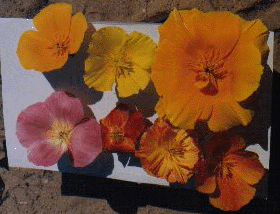
California Poppies, clockwise from upper left: Standard, Yellow-flowered, Mission Bells, Apricot, Rose Chiffon, Mikado, Purple Gleem.
Dry Bean Inoculant Test
I received a garden catalog two years ago that raved about the increased productivity of dry beans when inoculated with legume inoculant (a bacteria that grows on the plant's roots and helps them fix nitrogen from the air to act as a fertilizer). I decided to try and quantify how much inoculating increased production. While I was at it, I also tried testing the effect of adding another so-called super amendment... kelp meal. Here are the results:
Grams of dry beans produced per 100 live plants:
No inoculant, no kelp meal........... 1,980 grams
No inoculant, with kelp meal......... 2,240 grams
Inoculated, no kelp meal.............. 2,380 grams
Inoculated, with kelp meal............ 2,500 grams
As can be seen, the test was well-behaved with every addition showing an increase in productivity with the final result that using both increased productivity by 25 percent. However, if you had to choose between one or the other, inoculation increases productivity more than kelp meal.
Lady Bug Cages
I made a large screened cage to cover a section of my garden with the idea that it would concentrate lady bugs and encourage them to mate and lay eggs. Even though I used "Stay at Home" lady bugs, guaranteed to have been conditioned stay in the garden, all they wanted to do was cling to the screen and ignore aphids and each other. This idea was a complete bust. Another point, half of the batch of lady bugs I ordered, from the Gardens Alive Company, arrived dead. I called the company and asked them if this was typical and they said that it wasn't and would send a replacement batch free of charge. When this second batch arrived, 60 percent of the lady bugs were dead. Needless to say, this has really put me offer ordering lady bugs for the garden.
Here's a new sport for gardeners. I call it:
Junebug Bashing
Two of my neighbors have fruit trees that they just let the fruit rot on the branches. Naturally, this attracts a lot of Junebugs (big green flying beetles). These pests chomp on the fruit then blunder into my garden to lay eggs, which hatch into grubs that eat everything in sight. This morning I was sweeping the back porch when one of these beetles almost flew into my face. Something snapped inside me and in a fit of bestial fury I swung the broom at the thing. I got him, and the resounding thunk when the nasty bug was pounded to goo struck a chord in my soul. My eyes tightened, me knees instinctively bent into a combat stance, I stalked into the garden. Another one came blundering along. Thwack! A second glob of green bug goo dripped from the broom. A demented smile spread across my lips. I ran to the garage, looking for a more effective instrument of death. I found the perfect thing holding up dust in the garage... a badminton racket: light, flexible, and with just the right amount of reach.
I returned to the garden, heart pounding with anticipation of the carnage about to happen. Half-an-hour later the corpses of thirty-six Junebugs littered the garden. Exhausted, I collapsed on the garden swing, a gleeful smile stretching toward my ears. I call it "Junebug Bashing." As a sport it requires good hand-eye coordination, fleetness of foot, and flexibility to twist and turn as the bugs careen around you. I even worked out a point system; a bug on the ground or flower is worth one point, a bug in the air is two, and an overhead jump shot gets you three points. Under that system this morning's outing earned me sixty-three points. I know, I know. It sounds insane but there's something irresistible about the sound of one of those bugs coming face-to-face with his mortality against the strings on my little racket. Try it and see if you don't agree.
The Power of Triple-Digging
Two years ago I triple-dug my entire garden, working enormous amounts of shredded leaves, organic fertilizer, and pH-correcting sulfur into each level. The result was a rich bed 36 inches deep. The following year the rate of growth and productivity was unbelievable. One Savor melon produced 126 fruits!
The downside to this is that triple-digging is incredibly hard work. Only the young, fit, and fool-hardy should attempt it. Another negative is that the rampant growth that follows may be difficult to keep up with. That Savor melon grew to be over thirty feet in diameter and smothered several less-aggressive plants.
Peaches
I've grown the following peaches for ten years:
Madison
Sweethaven
Belle of Georgia
Strawberry Free
George IV
Carolina Belle
July Elberta
Stark Early
White Giant
Hale Haven
Rio Oso Gem
Reliance
Encore
Raritan Rose
... and found that Raritan Rose is the best-tasting of them all. It's very sweet, juicy, and has a deep rich peachy flavor. The tree is well-behaved and the fruits are medium-sized. Strawberry Free is a close second. It too is very sweet but has a mild, pear-like flavor that is mouth-watering. The sweetest peach was Sweethaven. Regretfully, Stark Bros., the last company to offer this variety, no longer carries it and my only Sweethaven tree just died. If anyone knows where I can order one, Thank you
On the negative side, I found Hale Haven, George IV, Madison, Carolina Belle, and Belle of Georgia uninteresting compared to the others.
Dry Beans
Since pink dry beans won the bean taste test in the Taste Testing page, I decided to try growing them. 200 square feet planted with seeds six inches apart (80 percent germination resulted on an average distance between plants of 8 inches) yielded 22.7 pounds of dry pink beans in 115 days.
I threshed the beans by grinding them under foot on a cloth-covered cement slab. They were winnowed by using a 1/2 inch sifter to remove course debris and an 1/8th inch screen to pass the fine debris. The remaining chaff was blow away by a fan forcing air up through the final screen. Any remaining bits of stem or damaged beans were hand-picked out of the good beans. The total time to harvest, thresh and winnow was 5.5 hours.
After cooking, this crop represents 70 pounds of high-quality food that is easily prepared and stores (before being cooked) almost indefinitely. I find that fresh dry beans have a richer, meatier flavor than those sold in stores.
The record for growing dry beans is 28 pounds per 100 square feet, over twice my yield.
Forever Flowers... a failure
Many of the things I try fail, this is one of them. I had the idea that I could make cut flowers last longer if, instead of cutting them, I stripped all the leaves off and dug the plant up, washed the roots off, and kept the roots in water. The idea was that the roots would be able to pump more water into the flower, keeping it fresh longer than a cut flower. The problem was that the roots rotted and the flower died in just three days. Changing the water daily didn't help. Oh well... back to the drawing board.
Making Raisins
Commercial raisins are make by piling bunches of grapes on pesticide-saturated paper and letting them dry in the sun. If you want to make your own, unpolluted raisins it's easy. Besides avoiding raisins that have been exposed to poison, making your own has the advantage that you can use more flavorful grapes than the tasteless Thompson Seedless that the raisin industry uses.
I've used four techniques for making raisins, only one works well for the home gardener. The first technique I tried was to leave the grapes hanging on the vine with the thought that the longer they remained on the vine, the sweeter they'd get. It didn't work. The grapes dried too slowly allowing fermentation to begin. The resulting raisins tasted like soured wine. The second technique was to cut whole bunches and dry them in the sun. They dried in four days and didn't ferment but the raisins weren't uniformly dried. Grapes in the center of the bunch were too moist and those on the outside were too hard. Worse still, picking the raisins off the clusters and trying to remove all the stems was a slow, tedious job. Also, these first two techniques don't allow you to wash the grapes prior to drying. The third technique involved picking grapes off the bunches, washing them and then drying them in a food dehydrator. This made removing all the stems easy and allowed a complete washing of the grapes. However, the dehydrator gave the raisins a smoky, burnt flavor.
The fourth, and best technique, involves picking the grapes off the bunches, washing them, then sun-drying inside a frame covered with fine, sheer-drapery material to prevent insects from getting at the grapes. The resulting raisins, made using Red Flame Seedless grapes, are the finest tasting I've ever had. Since different-sized grapes dry at different rates, it helps to sort them into small, medium and large grapes and dry each group in a different frame. I used a plastic tub with holes drilled in the bottom to make sorting easy. The small ones dry in two days, the mediums un three and the large in four. Drying times will vary depending on temperatures, solar intensity and relative humidity.
Green Beans
I compared Derby, E-Z pick, Green Lantern, Gator Green Improved, and Strike to see which of these, all advertised as having very straight pods, produced the greatest number of straight pods. The winner was Derby with 65 percent of its pods straight. Next came Green Lantern (54 percent straight), Strike (48 percent straight), Gator Green Improved (29 percent straight), and E-Z Pick (14 percent straight).
The purpose of this test was to find a variety with straight pods to make cutting them up easier. While Derby won, I'll only be planting E-Z Picks from now on.
Only E-Z Pick retained a bright green color after being cooked; all the others turned an unattractive olive-drab color. Also, E-Z Pick was the only true bush-type plant. It grew like a dwarf tree: tall, straight, and with no trailing vines. Its pods were held up high off the ground. The others grew like sort vines, trailing and tangling 2-3 foot runners that made finding the pods difficult. Finally, E-Z Pick got it's name from the ease with which the pods release from the plant, a slight pull and they fall into your hand. It's a one-handed process that allows you to harvest with both hands. The remaining varieties took two hands: one to hold the vine and the other to tear the pod off the plant. The time saved harvesting E-Z Pick beans more than made up for the extra time it took to cut up their pods because they were so curved.
Oh, yes. E-Z Pick is an open-pollinated variety so you can grow your own seed.
Watermelons
I tried Charleston Grey, Calhoun Grey, AU Jubilant, Allsweet, AU Producer, Klondike, Crimson Sweet, Congo, Dixielee, Kleckey Sweet and Sunset open-pollinated watermelons to find the sweetest, most intense red melon. Dixielee was the clear winner. It was so dark red that the rest looked grey-pink in comparison. It also had the sweetest taste and the seeds tend to form in tight little knots making cutting them out easy. It's one weakness is that if left to go completely ripe the heart tends to become pulpy. Fortunately, it's so sweet that it can be harvested early (ground spot yellow but thumping it gives a sound that's not completely dull and flat).
I'm trying a new variety called Legend this year. It's supposed to be dark red, pulpless, and holds well on the vine after being ripe. Check back in August and I'll let you know how it compares to Dixielee.
Dixielee also beat out the hybrids Funbell and Mini Jubilee.
Muskmelons
These are the orange-fleshed, corky-netted melons found in grocery stores. After trying Delicious, Market Pride, Hale's Best, Iroquois, Harvest Queen, School's Hard Shell, Minnesota Midget, Creme de la Creme, Sprint, Ambrosia, Touchdown, Spearmellon, Super 45, Fastbreak, Honey Rock, and Sugar Queen... I decided we had a tie. Ambrosia and Sugar Queen are both outstanding and far superior to all the others. Ambrosia is slightly sweeter but Sugar Queen is more attractive and finer-grained. My recommendation? Grow both!
Cantaloupes
Forget the "cantaloupe" signs in grocery stores; what they carry are really classed as muskmelons. True cantaloupes are small, smooth Charentais-type melons that are almost impossible to find. I've only tested Savor, Charentais, and Charmel II. The clear winner was Savor. Some of its 2-3 pound fruits reached 19 percent sugar. These melons are very strongly flavored too. Many taste tests rate Savor as the best tasting melon in the world. The flesh tends to be very firm so it's best to let them age for three days on the kitchen counter before eating. The 0.5-1 percent drop in sugar is more than made up by the improvement in texture.
I tried pruning some melon vines to grow just their main vines. The idea was to see if I could grow fewer melons per plant, have more different types of plants in a small space, and control the explosive grow melons have. It didn't work. Even limiting the vines to just one melon per vine, the melons only grew to half their normal size and all had such low sugar levels that they were uneatable.
Grains
Grains, like wheat and barley, are easy and beautiful to grow. They are also a nightmare to harvest. Forget about images of peasants gleefully beating seeds out of the stems to thresh them then throwing everything into the air to let the wind blow the chaff away from the seed. It works, but is very inefficient. Flaying the seeds with a stick or even something a benign as a small plastic baseball bat breaks 5 five percent of the seed and misses another 5 percent. Using wind, or a fan, costs another ten percent from small seeds being carried away and lost. The remaining 80 percent is so choked with small pieces of chaff that it's almost worthless. I'm currently working on techniques to improve the efficiency and ease of threshing and winnowing grains. I'll post that information as soon as I get it. If anyone knows where I can order small threshing and winnowing machines I'd appreciate their emailing me where I can get them.
Spinach
Hate spinach? You should. The varieties grown for markets are selected for productivity and shippability. not flavor. The sweetest, mildest spinach that came out of testing 15 different varieties is called Low Acid (so named because it has the lowest level of oxalic acid, which is what gives most spinaches their sharp taste). It's an open-pollinated variety so you can grow your own seed. Low Acid is sweeter and milder than most leaf lettuces and can be eaten (and enjoyed) raw. The next-best variety is Olympia, a readily available hybrid spinach.
Garden Productivity Rates
Growing a large garden full of food can be fun but if you're not prepared for the amount of work it takes to harvest a large crop, you may have to endure the pain of throwing out a lot of produce. Here are some numbers to consider before planting a large garden:
Type Picking/processing rate Harvest amount
beets ............ 10 pounds/hour ............. 0.1 pounds/square foot
broccoli ......... 10 ............................... 0.5
carrots .......... 4 ................................ 0.4
sweet corn .... 10 ............................... 0.5
bush green beans 2 .............................. 0.3
melons ........... 20 ............................... 0.5 (picked/cut-up)
green peas ....... 2 ............................... 0.2
pumpkin ........... 4 ............................... 0.3
spinach ............ 5 ............................... 0.7
pink dry beans ... 4 ............................... 0.12
Let's say you want 80 pounds of shelled and blanched peas. That'll take 80 pounds/0.2 pounds per square foot = 400 square feet or a twenty x twenty foot plot. When your crop comes in you'll need 80 pounds/2 pounds per hour = 40 hours (one full work-week) to pick and blanch that many peas. Most of that time will go to shelling. That's a lot of work. Worse still, the peas, like most crops, have to be picked when they are ripe, not when you have the time. Waiting a day or two past peak picking time will result in harder, drier peas that won't be worth the work.
One final word on the pea example, I tried saving time by using one of the small shellers sold in gardening magazines... it was a disaster. You have to cook the pods a minute to make them soft enough to shell without the sheller's rollers squashing the peas. That made the pods slimy and sticky to handle. Even then the sheller failed to work half of the time. In the end it was just as fast and easier to shell by hand. Pea shelling really isn't that bad because you don't have to look at your hands to do it. I usually sit down with a bucket of pods and watch movies while I shell to help the time go by.
Broccoli
After growing and comparing the following varieties of broccoli:
Emperor
Waltham 29
DeCicco
Barbados
Gallant
Packman
Calabrase
Green Goliath
Emerald
Dividend
Miracle
I found that Packman was the best. They all tasted the same but all except Packman either formed there heads with too many branches to the florets so that when cut apart, the pieces were too small to eat easily. Also. Many of the others matured the individual flowers buds at different rates making it impossible to decide when to harvest. Packman's flower buds matured at an even rate.
Zinnias
After comparing:
Thumbelina
Lollipop
Peter Pan
Star White
Pinwheel
Dasher
Dreamland
Starbright
Small World Pink
Profusion Cherry
Pulima
Border Beauty
Lilliput
Splendor
Come and Cut Again
Paintbrush
Dahlia Flowered
Giant Double
Sunshine
California Giants
Giant Fantasy
Giant Flowered
Giant Cactus
Oklahoma Mix
State Fair Giant
... I found
the undisputed best variety to be Burpee's Splendor Zinnia. It had
the biggest, brightest, best-shaped flowers in the best-balanced mix
of brilliant colors. From 100 feet away from the test plot the row of
Slendors were still easy to pick out. Most of the mixes were
dominated by a pink-violet color. Also, disregard what the seed
packages say about plant height. They only come in two heights: short
(12-16 inches tall) and tall (3-4 feet) The first 9 varieties in the
list are short.
Sweet Peas
I tried Royal White (Northrup King), Early Gigantea Mixed Colors (NK), Royal Scarlet (NK), Old Spice Mixed Colors (NK), Royal Blue (NK), and Burpee's Patio Mix. Royal White had the strongest, sweetest fragrance but was the latest (three weeks later than Early Gigantea, which was the earliest) flowering. Old Spice was advertised as having a strong scent but it seemed weaker than the others. Royal Scarlet was orange-red, not the pure red shown on the seed package. It also had the weakest fragrance. Royal Blue's color was not blue but varying shades of violet. Burpee's Patio Mix were a delight. Spaced eight inches apart in a small block they quickly grew into a solid mass of plants and flowers nine inches tall. They required no staking and even the strongest winds had no effect on them. Their fragrance wasn't demonstrative but planted over large areas it's strong enough the scent an entire back yard.
(Note: In 2006 I tried two patches of Burpee's Patio sweet pea and neither one grew into the compact, 9-inch tall plants they did the first time. This time they spread out into 18-inch long leggy monsters with very few flowers. These plantings used 12 packs of seeds so it wasn't a problem with one odd pack. I plan to try them again in the hopes that it was just a packing error.)
Loose Leaf Lettuce
Comparing Green Ice, Black-Seeded Simpson, Red Sails, Redoak, Prize Leaf, Ruby, Salad Bowl, and Red Salad bowl, I found that Green Ice had the crunchiest texture and the sweetest flavor.
Honeydew melons
Honeydews are
one of the best melons for the home gardener to grow because it is
impossible to find a fully-ripened honeydew in the grocery store.
Honeydews commonly split their skins at full ripeness making them
look unattractive so stores don't like to display them. Also, a
completely ripe honeydew is only good for a day or two before its
flesh begins to break down.
The
perfect honeydew has flesh with a strong green color, is intensely
sweet, tender and very juicy. There should be no watery, pulpiness
around the seed cavity. Most varieties produce good melons if they
are picked at the peak of their ripeness. The key is to know your
variety and pick it as soon as it's ready. For my favorite (Honey
King), the skin will have a few shallow cracks and the blossom end of
the melon will give 1/8 to 1/4 inch with a slight (3 to 4 pounds)
thumb pressure. If it gives half-an-inch the melon's overripe and
will be pulpy inside. Pick ripe melons and eat them the same day.
They get pulpy sitting around more than two days.
Varieties tested:
Earlidew - acceptably sweet but the flesh is too firm.
Morningdew - sweeter than Earlidew and its flesh is crunchy.
Sweet Delight - sweet but crunchy.
Ojo Caliente - Modest sweetness, firm.
Spanish Espanhol - Modest sweetness, soft.
Honey King - The sweetest, some melons topped 16 percent sugar (14 is very good and store-bought melons seldom get above 12.) The flesh is succulent, thick and has a rich flavor that goes beyond just being sweet. This is the best I've ever tasted.
I regret to say that while I've tested five other green-fleshed melons, the results of those tests were lost. However, Honey King was better than any of those.
Romaine lettuce
Romaine lettuce has many of the best attributes of both loose-leaf and head lettuces. While you can harvest entire heads, you can double the amount of leaves obtained from a plant by simply picking off the outside leaves as you need them. If you do harvest an entire head, I find it'll keep better if you treat it like a cut flower: keep the stem in clean water and give it a fresh cut every day.
Here are the results of two tests (One in spring and the other in Fall).
GREEN ROMAINES:
Sherwood: The sweetest and mildest flavored. Available from Thompson & Morgans. The problem is that It is only available in pelleted seed: $3.00 for 20 pellets and repeated tests indicate the germination rate of these pellets can be as low as 10 percent.
Paris White: Almost as good as Sherwood, a stronger grower, and 1/100th the price.
Parris Island: Virtually the same as Paris White.
Olga: sharp flavor.
Plato II: sharp.
Verte Mar: Meaty leaves but sharp flavor.
Green Tower: bitter.
Romaine Head: sharp flavored.
Medallion: sharp.
Green Romaine: sharp and bitter.
Winter Density: crisp but sharp and sour.
RED ROMAINES:
Cimmaron: beautiful plant. Darkest-red of the red varieties. Slightly-sharp flavor.
Rouge de Hiver: red, very sharp.
Majestic Red: Dark red, sharp.
Redcurl: mildest of the red romaines.
Rosilita: a little sharp. Most easily frost-damaged.
Rubens Romaine: very sharp flavor.
Little Gem: slightly sharp.
Little Caesar: slightly sharp.
Little Leprechaun: medium-red, sharply flavored.
Home-grown super-rich soil
Having a supply of rich soil for topping seeds is always useful. I make my own by mixing one part peat (ph=3.8) with two parts worm castings (grown from letting red worms chew up vegetable waste from the kitchen. ph=8.2), which gives a dark, rich, moisture-holding soil with a perfect ph of 6.6. For potting soil I use one part castings, one and one-third part peat and one part vermiculite (ph=6.8) for a mix with a 6.5 ph.
Cherry tomatoes
The goal in growing cherry tomatoes is to grow the sweetest fruit possible. A tomato's sweetness is determined by its percent sugar and acidity. One tomato can have less sugar than a second yet taste sweeter because its acidity is lower than the second. Armed with an electronic ph (or acidity) meter and a refractometer (for measuring sugar content in Brix (percent sugar)) I grew eight different cherries and compared them to store-bought tomatoes. In most cases dozens of each variety were tested. The numbers quoted here are averages of those tests. The sweetest tomatoes are those with the largest Brix (sugar) and highest ph (lowest acidity). Here are the results:
Store-bought: Brix=4.8 ph=4.1
Matt's Wild Cherry: Brix=4.0 ph=3.9
Sun Cherry: Brix=6.5 ph=4.2
Sun Gold: Brix=6.0 ph=4.5
Super Sweet 100 Brix=6.0 ph=4.1
Sugar Snack Brix=7.4 ph=4.1
Sweet Chelsea Brix=4.7 ph=4.0
Sweet Million Brix=7.1 ph=4.1
Sweetie Brix=6.0 ph=4.0
The winners, verified by taste testing, are Sun Gold and Sugar Snack. The acidity, or ph, is a nonlinear scale which means that a small increase in ph means the tomato will taste many times sweeter. Sun Gold is a winner because it's acidity is very low. Sugar Snack is outstanding because its sugar content is very high. (Now, if the plant breeders could combine the low acidity of Sun Gold with the sweetness of Sugar Snack we'd really have a great tomato.)
For comparison, unsweetened pineapple juice has a Brix of 16.2 and a ph of 3.8.
Sun Gold wins many taste tests because in addition to being very sweet it has a fruity/winey/tropical flavor that is truly unique. It's gold color also attracts fewer birds than red varieties. Unfortunately Sun Gold is very prone to cracking. It's common to lose half a crop to this problem. Sugar Snack is almost impervious to cracking.
Sugar Snack and Sun Gold seeds are available from Burpee Seeds (http://www.burpee.com/) (No... I don't own stock in this company.)
Growing tip: Cherry tomato plants are so productive I've found it advantageous to prune each cluster of tomatoes to a single string. This makes harvesting easier. By the way, how do you know which tomatoes of a long string to pick? Simple: find the lowest tomato on the string that looks ripe (the strings ripen from the top down) and count up the string (toward the riper tomatoes) ten tomatoes. Numbers 8,9,10, and 11 will be at peak sweetness. Seven and below will be tart and 12 and above, if they are still there, will be starting to ferment.
SWEETER GRAPES
Grape growers can increase the sugar content of their grapes fifty percent by resisting the urge to cut bunches from the vine and instead only picking those grapes out of each cluster as they reach perfect ripeness. Hunting grapes like this quickly becomes a delightful daily task just like venturing into a raspberry patch to hunt out the most succulent berries.
Growing grapes on a trellis that places ripening clusters at eye level makes hunting for those sweet treasures easy. One trellis that works well uses three frames shaped like the letter "Y" with the arms branching off five feet above the ground. The vine's trunk runs up the leg of the center "Y" to the starting point of the arms. Two laterals are trained horizontally from this point to the crotches of the two other frames. Fruiting shoots are trained up over wires stretched between the "Y" arms. This trellis maximizes airflow through the vines which helps prevent fungal diseases, allows growers to inspect the undersides of leaves for pests, and best of all holds ripening grapes at perfect sampling height.
Is the effort of harvesting individual grapes worth it? Definitely! Grapes harvested in bunches average twenty percent sugar. Grapes picked individually at optimal ripeness average thirty percent. The only problem with this system is that the grapes are so delicious few of them make it out of the garden.
The final question to consider is which type of grape to grow. I've tested Red Flame Seedless, Remaily, Thompson Seedless, Concord and Venus grapes and the best by far is Flame. Its superior sweetness, unique crunchy texture, and ease of growing make it ideal for the home gardener.
Birds and wasps can wipe out an entire grape crop. I thwart both by enclosing the grape bunches in cloth sacks closed tight with clothes pins. I tried paper bags once and while they protected the grapes, they caused red flame grapes to loose most of their crunch. Cloth didn't cause this problem. If you live in a high-humidity area I'd suggest using fiberglass screening to prevent mold problems.